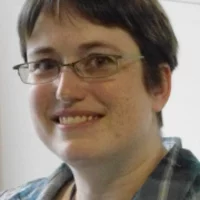Biography
Marianne Liebi is Tenure-Track Assistant Professor at EPF Lausanne and head of the group “Structure and Mechanics of Advanced Materials” at PSI. She has been appointed in 2021 at EPFL where she is part of the Institute of Materials within the School of Engineering. Marianne Liebi studied Food Science at ETH Zurich where she also obtained her PhD in 2013 in the Laboratory of Food Process Engineering lead by Prof. Erich J. Windhab. Within this project started using small-angle neutron scattering at PSI for the characterization of soft-matter, namely of magnetic alignable self-assembly structures. As a Postdoc in the coherent X-ray scattering group at the Swiss Light Source she worked from 2013-2016 on method development in SAXS tensor tomography. In 2016 she moved to Sweden where after a short period at the NanoMAX beamline, MAXIV Laboratory, Lund she started her own research group in 2017 as Assistant Professor at the Chalmers University of Technology, Gothenburg, and became Docent in Physics in spring 2020. She kept her affiliation at Chalmers University of Technology, where still part of her group is located (Liebi research group) when moving back to Switzerland in 2020 where she was Scientific Group Leader in the Center for X-ray Analytics at Empa, St.Gallen, before joining PSI in November 2021.
Institutional Responsibilities
Marianne Liebi is group leader of the Structure and Mechanics of Advanced Materials group in the Laboratory for Condensed Matter and Materials Science (LSC) withing the Photon Science Division at PSI.
Scientific Research
The focus of Marianne Liebi's research is in the development of advanced X-ray imaging techniques and their application towards materials with hierarchical structures. Her main expertise is small-angle X-ray scattering (SAXS) imaging in 2D and 3D, but include other imaging modalities such as ptychographic nanotomography, X-ray fluorescence or phase contrast tomography. The applications her group is working on in different collaborations are spanning a broad range from biomimetic hierarchical nanocomposites, materials based on cellulose, ink-based 3D printing, industrial injection-molded plastics as well as the characterization of bone and other biological tissues. A common denominator of these diverse applications is the arrangement of nanometer-sized building blocks within macroscopic samples, in particular the alignment of anisotropic constituents.
Selected Publications
For an extensive overview we kindly refer you to our publication repository DORA (includes publications since joining PSI).
A complete list of publications can be found on A-3821-2015 or google scholar
Appel, C. Schmeltz, M., Rodriguez-Fernandez, I., Anschuetz, L., Nielsen, L.C., Panepucci, E., Marijolovic, T., Wakonig, K., Ivanovic, A., Bonnin, A., Leonarski, F., Wojdyla, J., Tomizaki, T., Guizar-Sicairos, M., Smith, K., Beale, J. H., Glettig, W., McAuley, K. E., Bunk, O., Wang, M.* & Liebi, M.*
Fast Small-Angle X-Ray Scattering Tensor Tomography: An Outlook into Future Applications in Life Sciences
Small Methods 2500162, 1–11(2025). DOI: 10.1002/smtd.202500162
We demonstrate a fast implementation of small-angle X-ray scattering tensor tomography at the macrocrystallography beamline PX-I at PSI. As a show-case example from life science we show the organization of mineralized collagen in the long and lenticular process of the incus bone, one of the three human audiotry ossicles. The study reveals three distinct regions of high fibril alignment, most likely important pathways of sound throughout the ossicular chain, and highlights the technique's potential to aid in future developments in middle ear reconstructive surgery.
Chen, Y.*, Baroni, A.*, Tänzer, T., Nielsen, L. & Liebi, M.*
Reconstructing Three-Dimensional Optical Anisotropy with Tomographic Müller-Polarimetric Microscopy.
Advanced Science 2502075 (2025). DOI: 10.1002/advs.202502075
The 3D characterization of ultrastructure, nanoscales structures too small to be imaged using standard light microscopy approach, is key to understand hierarchical materials and their functional properties. We developed a new method, tomographic Müller-polarimetric microscopy (TMPM), that allows to retrieve at three-dimensional microscopic resolution the nanoscale structural information of the ultrastructure probed with polarized light in a non-destructive manner using a low cost and experimentally simple optical setup.
Carlsen, M.*, Malamud, F., Modregger, P., Wildeis, A., Hartmann, M., Brandt, R., Menzel A. & Liebi, M.
Texture tomography with high angular resolution utilizing sparsity.
J. Appl. Crystallogr. 58, 484–494 (2025). DOI: 10.1107/S1600576725001426
For anisotropic polycrystalline materials, where the the crystallites are neither small enough for tensor-tomography approaches nor large enough for established 3D XRD methods, texture tomography allows to reconstruct local orientation distribution functions. By connecting crystal symmetry directly with the reconstruction and making use of sparsity allows to reconstruct with a single tomography axis. This was here demonstrated on shot-peened martensite samples allowing to map the twinning microstrocture in the interior of a bulk sample and as biological example the mosaic microstructure in a gastropod (Romain snail) shell.
Grünewald, T.A.†, Liebi, M.†, Wittig, N.K. , Johannes, A. Sikjaer, T., Rejnmark, L., Gao, Z., Rosenthal, M, Guizar-Sicairos, M., Birkedal, H.* and Burghammer, M.* "Mapping the 3D orientation of nanocrystals and nanostructures in human bone: indications of novel structural features" Science Advances 2020, 6, DOI: 10.1126/sciadv.aba4171
† these authors contributed equally to this work
The implementation of SAXS tensor tomography with a small beamsize at the ID13 beamline at ESRF combined with pushing the method to extend to WAXS tensor tomography has resulted in insight into new structural features of bones, namely the localized difference in orientation distribution between the nanostructure and the biomineral crystals in specific bands, challenging the current bone models.
Liebi, M.*, Georgiadis,M., Menzel,A., Schneider,P., Kohlbrecher,J., Bunk,O., Guizar-Sicairos, M.* "Nanostructure surveys of macroscopic specimens by small-angle scattering tensor tomography." Nature 2015, 527, 349-352. DOI: 10.1038/nature16056
Introduction of a new method, SAXS tensor tomography, which allows the reconstruction of the full 3D reciprocal space map in three-dimensional samples. The method has been demonstraded on trabecular bone, showing the orientation of the nanoscaled mineralized collagen fibrils.


